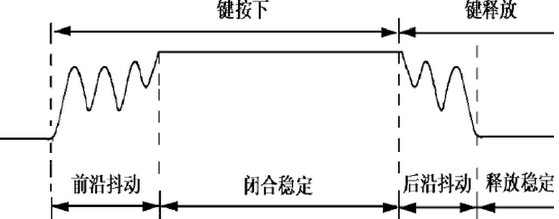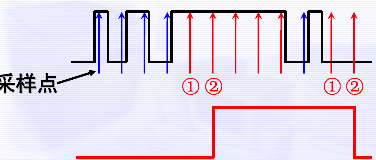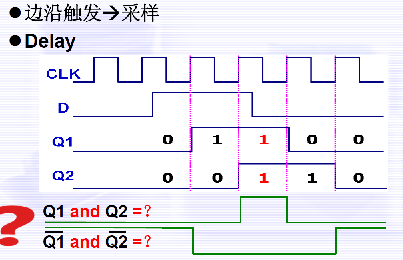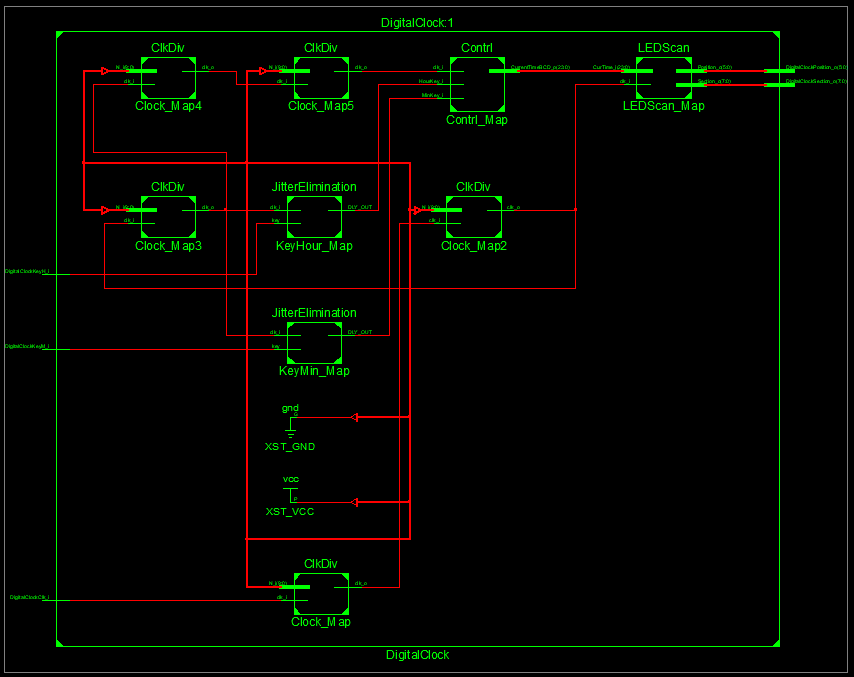序言
这个是我在做FPGA界的HelloWorld——数字钟设计时随手写下的,再现了数字钟设计的过程
目标分析
- 时钟具有时分秒的显示,需6个数码管。为了减小功耗采用扫描法显示
- 按键设置时间,需要对按键进行消抖
- 时分秒即为2个60进制计数器,一个24进制计数器。

模块设计
综上所述,我采用模块化设计方法进行设计,绘制框图如下。
- 时钟分频产生各个模块所需频率时钟。
- 按键处理模块对按键信号进行消抖、变长脉冲为短脉冲等处理。
- 时间控制模块产生时间信号或对时间进行设置。
- 数码管驱动模块负责对时间信号BCD码译码为数码管的段码并且扫描输出到数码管。
下面对各个模块分别详细叙述

时钟分频模块
我打算把时钟分频模块做成“数控N分频器”,通过给分频器传入数值N来对时钟信号进行N分频。得到的信号频率为原时钟信号的频率/N,占空比为1/N。
稍微考虑下其他模块所需时钟:按键处理模块100Hz ,时间控制模块1Hz,数码管驱动50Hz。而输入时钟为33.8688MHz。
我不想传入的N数值过大,我打算先对时钟进行两次:第一次调用时钟分频模块得到1Mhz,第二次得到1Khz。这样N的位数为10可以满足需求。
代码如下
library IEEE;
use IEEE.STD_LOGIC_1164.all;
use IEEE.STD_LOGIC_UNSIGNED.all;
entity ClkDiv is
port(
clk_i:IN STD_LOGIC;
N_i: IN STD_LOGIC_VECTOR(9 DOWNTO 0);
clk_o:OUT STD_LOGIC);
end ClkDiv;
architecture behavior of ClkDiv is
signal count:STD_LOGIC_VECTOR(9 DOWNTO 0):="0000000001";
signal clk_temp:STD_LOGIC:='0';
begin
process(clk_i)
begin
if(clk_i'EVENT and clk_i='1')then
if (count=N_i)then
count<="0000000001";
clk_temp<='1';
else
count<=count+1;
clk_temp<='0';
end if;
end if;
end process;
clk_o<=clk_temp;
end behavior;
仿真结果如下:
2分频:输出信号为f/2Hz,占空比1:2

3分频:输出信号为f/3Hz,占空比1:3

按键处理模块
去抖动根据以往的经验,按键按下弹起电平会有一小段毛刺,可能会引起电路误操作,所以要对按键进行消抖处理使变为干净的矩形信号。



抖动时间一般为10ms,若采样时间为10ms则噪声最多采样到一次。
对于两级D触发器,Q1和Q2之间有一个时间延迟效果。每一次时钟上升沿就是对信号采样一次,Q1保存的是最新一次的采样,Q2保存的是上一次的采样,Q1和Q2之间有一个时间延迟,时间为时钟周期。
对于噪声信号只能采样到一次,Q1*Q2的值一定为0。
对于持续时间大于时钟周期的信号可以采样到两次,Q1的值和Q2的值相同,Q1*Q2为信号电平。这就是去抖原理。


代码如下
library IEEE;
use IEEE.STD_LOGIC_1164.all;
use IEEE.STD_LOGIC_UNSIGNED.all;
entity JitterElimination is
port(
key: IN STD_LOGIC;
clk_i:IN STD_LOGIC;
DLY_OUT:OUT STD_LOGIC);
end JitterElimination;
architecture rtl of JitterElimination is
signal D1,D2,S:STD_LOGIC;
begin
process(clk_i)
begin
if (clk_i'EVENT and clk_i='1')then
D1<=key;
D2<=D1;
end if;
end process;
S<=D1 and D2;
DLY_OUT<=S;
end rtl;
仿真结果如下

可以看到,按键的抖动被消除了,但是可以看到按键按下电平持续时间跨过几个时钟周期。如果有必要可以使用微分电路把矩形波转换为窄脉冲波,这里不需要。
数码管驱动模块
时分秒显示需要2+2+2=6个数码管,每个数码管的显示需要8根引脚。使用扫描方式显示,只需要6+8=14根引脚,功耗比较低。
输入:时间信号BCD码有4*6=24位,用于控制扫描频率的时钟信号是1个输入信号
输出:位选信号6位,段码8位
library IEEE;
use IEEE.STD_LOGIC_1164.all;
entity LEDScan is
port(
CurTime_i: IN STD_LOGIC_VECTOR(23 DOWNTO 0);
clk_i:IN STD_LOGIC;
Position_o:OUT STD_LOGIC_VECTOR(5 DOWNTO 0);
Section_o: OUT STD_LOGIC_VECTOR(7 DOWNTO 0));
function convert(BCD:STD_LOGIC_VECTOR(3 DOWNTO 0)) return STD_LOGIC_VECTOR is
variable Section: STD_LOGIC_VECTOR(7 DOWNTO 0);
begin
Case BCD is
when "0000" =>Section:="00111111"; --段码表————————————---------------------------------------------
when "0001" =>Section:="00000110"; --0x3f,0x06,0x5b,0x4f,0x66,
when "0010" =>Section:="01011011"; --0x6d,0x7d,0x07,0x7f,0x6f,0x77,0x7c,0x39,0x5e,0x79,0x71
when "0011" =>Section:="01001111";
when "0100" =>Section:="01100110";
when "0101" =>Section:="01101101";
when "0110" =>Section:="01111101";
when "0111" =>Section:="00000111";
when "1000" =>Section:="01111111";
when "1001" =>Section:="01101111";
when OTHERS =>Section:="01100110";--01110001
-- when "0000" =>Section:="11000000"; --段码表{0x88,0x83,0xc6,0xa1,0x86,0x8e}----------------
-- when "0001" =>Section:="11111001"; --0xc0,0xf9,0xa4,0xb0,0x99,
-- when "0010" =>Section:="10100100"; --0x92,0x82,0xf8, 0x80,0x90,
-- when "0011" =>Section:="10110000";
-- when "0100" =>Section:="10011001";
--
-- when "0101" =>Section:="10010010";
-- when "0110" =>Section:="10000010";
-- when "0111" =>Section:="11111000";
-- when "1000" =>Section:="10000000";
-- when "1001" =>Section:="10010000";
-- when OTHERS =>Section:="10001110";
end case;
return Section;
end convert;
end LEDScan;
architecture behaviour of LEDScan is
signal CurTimeTemp:STD_LOGIC_VECTOR(23 DOWNTO 0):="000000000000000000000000";
signal SectionTemp,Section0,Section1,Section2,Section3,Section4,Section5: STD_LOGIC_VECTOR(7 DOWNTO 0):="00111111";--此处应为0的段码,数码管共阴数码管-----------------------------------------------------------------------
signal Position :integer :=5;
begin
process(clk_i)
begin
if (clk_i'EVENT and clk_i='1') then
CurTimeTemp<=CurTime_i;
Section0<=convert(CurTimeTemp(3 DOWNTO 0));
Section1<=convert(CurTimeTemp(7 DOWNTO 4));
Section2<=convert(CurTimeTemp(11 DOWNTO 8));
Section3<=convert(CurTimeTemp(15 DOWNTO 12));
Section4<=convert(CurTimeTemp(19 DOWNTO 16));
Section5<=convert(CurTimeTemp(23 DOWNTO 20));
if (Position=5)then
Position<=0;
else
Position<=Position+1;
end if;
case Position is
when 0 =>Section_o<=Section0;Position_o<="000001";
when 1 =>Section_o<=Section1;Position_o<="000010";
when 2 =>Section_o<='1'&Section2(6 downto 0);Position_o<="000100"; --添加小数点
when 3 =>Section_o<=Section3;Position_o<="001000";
when 4 =>Section_o<='1'&Section4(6 downto 0);Position_o<="010000";
when 5 =>Section_o<=Section5;Position_o<="100000";
when OTHERS=>NULL;
end case;
end if;
end process;
end behaviour;
仿真结果如下图所示

我们可以看到在当前时间为23:59:59的情况下Section5里面放的是2的段码,Section4里面放的是3的段码,Section3里面放的是5的段码
在时钟的作用下,Position_o依次选中个位,Section_o输出的是选中位置的段码。
时间控制模块
我想用两个按键分别设置分钟,时钟数值。分钟增1的条件是按键按下或者秒计数器进位,时钟增1的条件是按键2按下或者分钟计数器进位。这样可以在不破坏正常运行状态的情况下,用按键对分、时进行加1操作(设置),满足了功能又没有增加设计的复杂度。
最后将计数器的值翻译为BCD码,连接到一起形成24位BCD码。
输入:按键1和按键2、1Hz时间脉冲
输出:24位BCD码
N进制计数器
library IEEE;
use ieee.std_logic_1164.all;
use ieee.std_logic_arith.all;
use ieee.std_logic_unsigned.all;
use ieee.numeric_std.all;
entity Counter is
port(
CountClk:in STD_LOGIC;
N: in STD_LOGIC_VECTOR(4 downto 0);
count:out STD_LOGIC_VECTOR(4 downto 0);
Cout:out STD_LOGIC);
end Counter;
architecture behav of Counter is
signal count_temp: STD_LOGIC_VECTOR(4 downto 0):="00000";
signal CoutTemp:STD_LOGIC:='0';
begin
process(CountClk)
begin
if (CountClk'EVENT and CountClk='1')then
count_temp<=count_temp+1;
CoutTemp<='0';
if (count_temp>=N)then
count_temp<="00000";
CoutTemp<='1';
end if;
end if;
end process;
Cout<=CoutTemp;
count<=count_temp;
end behav;
控制模块
library IEEE;
use ieee.std_logic_1164.all;
use ieee.std_logic_arith.all;
use ieee.std_logic_unsigned.all;
use ieee.numeric_std.all;
entity Contrl is
port(
MinKey_i:IN STD_LOGIC;
HourKey_i:IN STD_LOGIC;
clk_i:IN STD_LOGIC;
CurrentTimeBCD_o: OUT STD_LOGIC_VECTOR(23 downto 0));
end Contrl;
architecture behavior of Contrl is
signal h: integer range 0 to 23 := 0; -- 秒钟个位
signal m: integer range 0 to 59 := 0; -- 秒钟个位
signal s: integer range 0 to 59 := 0; -- 秒钟个位
signal s1: integer range 0 to 9 := 0; -- 秒钟个位
signal s2: integer range 0 to 5 := 0; -- 秒钟百位
signal m1: integer range 0 to 9 := 0; -- 分钟个位
signal m2: integer range 0 to 5 := 0; -- 分钟百位
signal h1: integer range 0 to 9 := 0; -- 时钟个位
signal h2: integer range 0 to 2 := 0; -- 时钟百位
signal CurrentTimeBCD : STD_LOGIC_VECTOR(23 downto 0):="000000000000000000000000";
constant N9:STD_LOGIC_VECTOR(4 downto 0):="01001";
constant N5:STD_LOGIC_VECTOR(4 downto 0):="00101";
constant N1:STD_LOGIC_VECTOR(4 downto 0):="00001";
constant N23:STD_LOGIC_VECTOR(4 downto 0):="10111";
signal CountS1:STD_LOGIC_VECTOR(4 downto 0):="00000";
signal CountS2:STD_LOGIC_VECTOR(4 downto 0):="00000";
signal CountH:STD_LOGIC_VECTOR(4 downto 0):="00000";
signal CountM1:STD_LOGIC_VECTOR(4 downto 0):="00000";
signal CountM2:STD_LOGIC_VECTOR(4 downto 0):="00000";
signal CountH1:STD_LOGIC_VECTOR(4 downto 0):="00000";
signal CountH2:STD_LOGIC_VECTOR(4 downto 0):="00000";
signal KeyMTemp:STD_LOGIC:='1';
signal KeyHTemp:STD_LOGIC:='1';
signal CoutS1:STD_LOGIC:='0';
signal CoutS2:STD_LOGIC:='0';
signal CoutM1:STD_LOGIC:='0';
signal CoutM2:STD_LOGIC:='0';
signal CoutH:STD_LOGIC:='0';
signal CoutH1:STD_LOGIC:='0';
signal CoutH2:STD_LOGIC:='0';
component Counter is
port(
CountClk:in STD_LOGIC;
N: in STD_LOGIC_VECTOR(4 downto 0);
count:out STD_LOGIC_VECTOR(4 downto 0);
Cout:out STD_LOGIC);
end component;
begin
KeyMTemp<=CoutS2 xor (not MinKey_i);
KeyHTemp<=CoutM2 xor (not HourKey_i);
S1_Map: Counter port map(
CountClk=> clk_i,
N=>N9,
count=>CountS1,
cout=>CoutS1);
S2_Map: Counter port map(
CountClk=> CoutS1,
N=>N5,
count=>CountS2,
cout=>CoutS2);
M1_Map: Counter port map(
CountClk=>KeyMTemp ,
N=>N9,
count=>CountM1,
cout=>CoutM1);
M2_Map: Counter port map(
CountClk=> CoutM1,
N=>N5,
count=>CountM2,
cout=>CoutM2);
H1_Map: Counter port map(
CountClk=> KeyHTemp,
N=>N23,
count=>CountH,
cout=>CoutH);
process(CountH)
begin
case CountH is
when "00000" =>CountH2<="00000";CountH1<="00000";
when "00001" =>CountH2<="00000";CountH1<="00001";
when "00010" =>CountH2<="00000";CountH1<="00010";
when "00011" =>CountH2<="00000";CountH1<="00011";
when "00100"=>CountH2<="00000";CountH1<="00100";
when "00101" =>CountH2<="00000";CountH1<="00101";
when "00110" =>CountH2<="00000";CountH1<="00110";
when "00111" =>CountH2<="00000";CountH1<="00111";
when "01000" =>CountH2<="00000";CountH1<="01000";
when "01001" =>CountH2<="00000";CountH1<="01001";
when "01010"=>CountH2<="00001";CountH1<="00000";
when "01011" =>CountH2<="00001";CountH1<="00001";
when "01100" =>CountH2<="00001";CountH1<="00010";
when "01101" =>CountH2<="00001";CountH1<="00011";
when "01110" =>CountH2<="00001";CountH1<="00100";
when "01111" =>CountH2<="00001";CountH1<="00101";
when "10000" =>CountH2<="00001";CountH1<="00110";
when "10001" =>CountH2<="00001";CountH1<="00111";
when "10010" =>CountH2<="00001";CountH1<="01000";
when "10011" =>CountH2<="00001";CountH1<="01001";
when "10100" =>CountH2<="00010";CountH1<="00000";
when "10101" =>CountH2<="00010";CountH1<="00001";
when "10110" =>CountH2<="00010";CountH1<="00010";
when "10111" =>CountH2<="00010";CountH1<="00011";
when OTHERS=>NULL;
end case;
-- process(HourKey_i)
-- begin
-- if (HourKey_i'EVENT and HourKey_i='1') then
-- if h<23 then
-- h<=h+1;
-- else
-- h<=0;
-- end if;
-- end if;
-- end process;
--
-- process(MinKey_i)
-- begin
-- if (MinKey_i'EVENT and MinKey_i='1') then
-- if m<59 then
-- m<=m+1;
-- else
-- m<=0;
-- end if;
-- end if;
-- end process;
-- if s1<9 then
-- s1<=s1+1;
-- else
-- s1<=0;
-- if s2<5 then
-- s2<=s2+1;
-- else
-- s2<=0;
-- if m1<9 then
-- m1<=m1+1;
-- else
-- m1<=0;
-- if m2<5 then
-- m2<=m2+1;
-- else
-- m2<=0;
-- if h2<2 then
-- if h1<9 then
-- h1<=h1+1;
-- else
-- h1<=0;
-- h2<=h2+1;---可以断定这里加一
-- end if;
-- elsif h2>1 then
-- if h1<3 then
-- h1<=h1+1;
-- else
-- h1<=0;
-- h2<=0;
-- end if;
-- end if;
-- end if;
-- end if;
-- end if;
-- end if;
-- end if ;
--
-- if (MinKey_i'EVENT and MinKey_i='1') then ------可能要根据按键高电平有效还是低电平有效修改 假设按下接到地
-- if m1<=9 then
-- m1<=m1+1;
-- else
-- m1<=0;
-- if m2<=5 then
-- m2<=m2+1;
-- else
-- m2<=0;
-- end if;
-- end if;
-- end if;
-- if (HourKey_i'EVENT and HourKey_i='1') then ------可能要根据按键高电平有效还是低电平有效修改
-- if h2<2 then
-- if h1<9 then
-- h1<=h1+1;
-- else
-- h1<=0;
-- h2<=h2+1;---可以断定这里加一
-- end if;
-- elsif h2>1 then
-- if h1<3 then
-- h1<=h1+1;
-- else
-- h1<=0;
-- h2<=0;
-- end if;
-- end if;
-- end if;
--
--
--
--
-- IF(clk_i'EVENT and clk_i='1')then
-- if (HourKey_i='0') then
-- if h<23 then
-- h<=h+1;
-- else
-- h<=0;
-- end if;
-- end if;
--
-- if ( MinKey_i='0') then
-- if m<59 then
-- m<=m+1;
-- else
-- m<=0;
-- end if;
-- end if;
--
-- if s<59 then
-- s<=s+1;
-- else
-- s<=0;
-- if m<59 then
-- m<=m+1;
-- else
-- m<=0;
-- if h<23 then
-- h<=h+1;
-- else
-- h<=0;
-- end if;
-- end if;
-- end if;
--
--
--
-- end if;
--
--
--
--
--
--
-- h1<=h mod 10;
-- h2<=(h - h1)/10;
--
-- m1<=m mod 10;
-- m2<=(m - m1)/10;
--
-- s1<=s mod 10;
-- s2<=(s - s1)/10;
--
--
--
s1<=CONV_INTEGER(CountS1);
s2<=CONV_INTEGER(CountS2);
m1<=CONV_INTEGER(CountM1);
m2<=CONV_INTEGER(CountM2);
h1<=CONV_INTEGER(CountH1);
h2<=CONV_INTEGER(CountH2);
CurrentTimeBCD(3 downto 0) <= std_logic_vector(to_unsigned(s1, 4));
CurrentTimeBCD(7 downto 4) <= std_logic_vector(to_unsigned(s2, 4));
CurrentTimeBCD(11 downto 8) <= std_logic_vector(to_unsigned(m1, 4));
CurrentTimeBCD(15 downto 12) <= std_logic_vector(to_unsigned(m2, 4));
CurrentTimeBCD(19 downto 16) <= std_logic_vector(to_unsigned(h1, 4));
CurrentTimeBCD(23 downto 20) <= std_logic_vector(to_unsigned(h2, 4));
end process;
CurrentTimeBCD_o<=CurrentTimeBCD;
end behavior;
仿真结果如下
小时

分钟

秒钟

下图中输出CurrentTimeBCD_o旁边的数值105238表示带有时间信息的BCD码表示的时间10点52分38秒

顶层模块
顶层模块就是把上面各个模块根据下图用线连接起来。下图为简洁只画了一个按键
稍微分析端口:
输入:按键1、按键2、时钟输入
输出:6位的位选信号、8位的段码信号

代码如下
library IEEE;
use IEEE.STD_LOGIC_1164.all;
entity DigitalClock is
port(
DigitalClockClk_i:IN STD_LOGIC;
DigitalClockKeyM_i:IN STD_LOGIC;
DigitalClockKeyH_i:IN STD_LOGIC;
DigitalClockPosition_o:OUT STD_LOGIC_VECTOR(5 DOWNTO 0);
DigitalClockSection_o: OUT STD_LOGIC_VECTOR(7 DOWNTO 0));
end DigitalClock;
architecture rtl of DigitalClock is
component ClkDiv is
port(
clk_i:IN STD_LOGIC;
N_i: IN STD_LOGIC_VECTOR(9 DOWNTO 0);
clk_o:OUT STD_LOGIC);
end component;
component JitterElimination is
port(
key: IN STD_LOGIC;
clk_i:IN STD_LOGIC;
DLY_OUT:OUT STD_LOGIC);
end component;
component LEDScan is
port(
CurTime_i: IN STD_LOGIC_VECTOR(23 DOWNTO 0);
clk_i:IN STD_LOGIC;
Position_o:OUT STD_LOGIC_VECTOR(5 DOWNTO 0);
Section_o: OUT STD_LOGIC_VECTOR(7 DOWNTO 0));
end component;
component Contrl is
port(
MinKey_i:IN STD_LOGIC;
HourKey_i:IN STD_LOGIC;
clk_i:IN STD_LOGIC;
CurrentTimeBCD_o: OUT STD_LOGIC_VECTOR(23 downto 0));
end component;
signal N1: STD_LOGIC_VECTOR(9 DOWNTO 0):="0000100010";
signal Clk1M: STD_LOGIC:='0';
signal N2: STD_LOGIC_VECTOR(9 DOWNTO 0):="1111101000";
signal Clk1k: STD_LOGIC:='0';
signal N3: STD_LOGIC_VECTOR(9 DOWNTO 0):="0000001010";
signal Clk100Hz: STD_LOGIC:='0';
signal N4: STD_LOGIC_VECTOR(9 DOWNTO 0):="0000000010";
signal Clk50Hz: STD_LOGIC:='0';
signal N5: STD_LOGIC_VECTOR(9 DOWNTO 0):="0000110010";
signal Clk1Hz: STD_LOGIC:='0';
signal K1:STD_LOGIC:='1';--未按下
signal K2:STD_LOGIC:='1';--未按下
signal BCD:STD_LOGIC_VECTOR(23 downto 0):="000000000000000000000000";
begin
Clock_Map: ClkDiv port map(
clk_i=>DigitalClockClk_i,
N_i=>N1,
clk_o=>Clk1M);
Clock_Map2: ClkDiv port map(
clk_i=>Clk1M,
N_i=>N2,
clk_o=>Clk1k);
Clock_Map3: ClkDiv port map(
clk_i=>Clk1k,
N_i=>N3,
clk_o=>Clk100Hz);
Clock_Map4: ClkDiv port map(
clk_i=>Clk100Hz,
N_i=>N4,
clk_o=>Clk50Hz);
Clock_Map5: ClkDiv port map(
clk_i=>Clk50Hz,
N_i=>N5,
clk_o=>Clk1Hz);
KeyMin_Map:JitterElimination port map(
key=>DigitalClockKeyM_i,
clk_i=>Clk100Hz,
DLY_OUT=>K1);
KeyHour_Map:JitterElimination port map(
key=>DigitalClockKeyH_i,
clk_i=>Clk100Hz,
DLY_OUT=>K2);
Contrl_Map: Contrl port map(
MinKey_i=>K1,
HourKey_i=>K2,
clk_i=>Clk1Hz,
CurrentTimeBCD_o=>BCD);
LEDScan_Map: LEDScan port map(
CurTime_i=>BCD,
clk_i=>Clk1k,
Position_o=>DigitalClockPosition_o,
Section_o=>DigitalClockSection_o);
end rtl;
由于33.8688Mhz太大,软件仿真时间会比较慢,所以我没有把软件仿真图放出来。等过些时候到FPGA板子上验证

实验结果:符合设计预期结果,时分秒显示、按键都正常。
误差分析
由于1Mhz的时钟是由33.8688Mhz经过34分频生成的,所以每秒会有0.1078s的误差,也就是说1s过后此数字钟觉得时间过了1.1078s。分频方面我欠考虑了,如果想要提高精度要在分频方面思考。
生成原理图

尾声
新司机上路,各位系好安全带